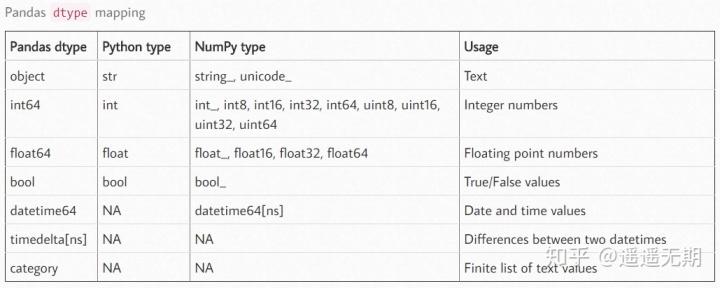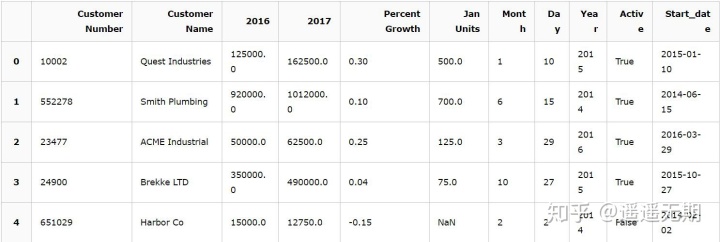数据处理过程的数据类型
- 当利用pandas进行数据处理的时候,经常会遇到数据类型的问题,当拿到数据的时候,首先需要确定拿到的是正确类型的数据,一般通过数据类型的转化,这篇文章就介绍pandas里面的数据类型(data types也就是常用的dtyps),以及pandas与numpy之间的数据对应关系。

- 主要介绍object,int64,float64,datetime64,bool等几种类型,category与timedelta两种类型会单独的在其他文章中进行介绍。当然本文中也会涉及简单的介绍。
数据类型的问题一般都是出了问题之后才会发现的,所以有了一些经验之后就会拿到数据之后,就直接看数据类型,是否与自己想要处理的数据格式一致,这样可以从一开始避免一些尴尬的问题出现。那么我们以一个简单的例子,利用jupyter notebook进行一个数据类型的介绍。
####按照惯例导入两个常用的数据处理的包,numpy与pandas
import numpy as np
import pandas as pd
# 从csv文件读取数据,数据表格中只有5行,里面包含了float,string,int三种数据python类型,也就是分别对应的pandas的float64,object,int64
# csv文件中共有六列,第一列是表头,其余是数据。
df = pd.read_csv("sales_data_types.csv")
print(df)
Customer Number Customer Name 2016 2017
0 10002 Quest Industries $125,000.00 $162,500.00
1 552278 Smith Plumbing $920,000.00 $1,012,000.00
2 23477 ACME Industrial $50,000.00 $62,500.00
3 24900 Brekke LTD $350,000.00 $490,000.00
4 651029 Harbor Co $15,000.00 $12,750.00
Percent Growth Jan Units Month Day Year Active
0 30.00% 500 1 10 2015 Y
1 10.00% 700 6 15 2014 Y
2 25.00% 125 3 29 2016 Y
3 4.00% 75 10 27 2015 Y
4 -15.00% Closed 2 2 2014 N
df.dtypes
Customer Number int64
Customer Name object
2016 object
2017 object
Percent Growth object
Jan Units object
Month int64
Day int64
Year int64
Active object
dtype: object
# 假如想得到2016年与2017年的数据总和,可以尝试,但并不是我们需要的答案,因为这两列中的数据类型是object,执行该操作之后,得到是一个更加长的字符串,
# 当然我们可以通过df.info() 来获得关于数据框的更多的详细信息,
df['2016']+df['2017']
0 $125,000.00 $162,500.00
1 $920,000.00 $1,012,000.00
2 $50,000.00 $62,500.00
3 $350,000.00 $490,000.00
4 $15,000.00 $12,750.00
dtype: object
df.info()
# Customer Number 列是float64,然而应该是int64
# 2016 2017两列的数据是object,并不是float64或者int64格式
# Percent以及Jan Units 也是objects而不是数字格式
# Month,Day以及Year应该转化为datetime64[ns]格式
# Active 列应该是布尔值
# 如果不做数据清洗,很难进行下一步的数据分析,为了进行数据格式的转化,pandas里面有三种比较常用的方法
# 1. astype()强制转化数据类型
# 2. 通过创建自定义的函数进行数据转化
# 3. pandas提供的to_nueric()以及to_datetime()
<class 'pandas.core.frame.DataFrame'>
RangeIndex: 5 entries, 0 to 4
Data columns (total 10 columns):
Customer Number 5 non-null int64
Customer Name 5 non-null object
2016 5 non-null object
2017 5 non-null object
Percent Growth 5 non-null object
Jan Units 5 non-null object
Month 5 non-null int64
Day 5 non-null int64
Year 5 non-null int64
Active 5 non-null object
dtypes: int64(4), object(6)
memory usage: 480.0+ bytes首先介绍最常用的astype()
比如可以通过astype()将第一列的数据转化为整数int类型
df['Customer Number'].astype("int")
# 这样的操作并没有改变原始的数据框,而只是返回的一个拷贝
0 10002
1 552278
2 23477
3 24900
4 651029
Name: Customer Number, dtype: int32
# 想要真正的改变数据框,通常需要通过赋值来进行,比如
df["Customer Number"] = df["Customer Number"].astype("int")
print(df)
print("--------"*10)
print(df.dtypes)
Customer Number Customer Name 2016 2017
0 10002 Quest Industries $125,000.00 $162,500.00
1 552278 Smith Plumbing $920,000.00 $1,012,000.00
2 23477 ACME Industrial $50,000.00 $62,500.00
3 24900 Brekke LTD $350,000.00 $490,000.00
4 651029 Harbor Co $15,000.00 $12,750.00
Percent Growth Jan Units Month Day Year Active
0 30.00% 500 1 10 2015 Y
1 10.00% 700 6 15 2014 Y
2 25.00% 125 3 29 2016 Y
3 4.00% 75 10 27 2015 Y
4 -15.00% Closed 2 2 2014 N
--------------------------------------------------------------------------------
Customer Number int32
Customer Name object
2016 object
2017 object
Percent Growth object
Jan Units object
Month int64
Day int64
Year int64
Active object
dtype: object
# 通过赋值在原始的数据框基础上进行了数据转化,可以重新看一下我们新生成的数据框
print(df)
Customer Number Customer Name 2016 2017
0 10002 Quest Industries $125,000.00 $162,500.00
1 552278 Smith Plumbing $920,000.00 $1,012,000.00
2 23477 ACME Industrial $50,000.00 $62,500.00
3 24900 Brekke LTD $350,000.00 $490,000.00
4 651029 Harbor Co $15,000.00 $12,750.00
Percent Growth Jan Units Month Day Year Active
0 30.00% 500 1 10 2015 Y
1 10.00% 700 6 15 2014 Y
2 25.00% 125 3 29 2016 Y
3 4.00% 75 10 27 2015 Y
4 -15.00% Closed 2 2 2014 N
# 然后像2016,2017 Percent Growth,Jan Units 这几列带有特殊符号的object是不能直接通过astype("flaot)方法进行转化的,
# 这与python中的字符串转化为浮点数,都要求原始的字符都只能含有数字本身,不能含有其他的特殊字符
# 我们可以试着将将Active列转化为布尔值,看一下到底会发生什么,五个结果全是True,说明并没有起到什么作用
#df["Active"].astype("bool")
df['2016'].astype('float')
---------------------------------------------------------------------------
ValueError Traceback (most recent call last)
<ipython-input-19-47cc9d68cd65> in <module>()
----> 1 df['2016'].astype('float')
C:Anaconda3libsite-packagespandascoregeneric.py in astype(self, dtype, copy, raise_on_error, **kwargs)
3052 # else, only a single dtype is given
3053 new_data = self._data.astype(dtype=dtype, copy=copy,
-> 3054 raise_on_error=raise_on_error, **kwargs)
3055 return self._constructor(new_data).__finalize__(self)
3056
C:Anaconda3libsite-packagespandascoreinternals.py in astype(self, dtype, **kwargs)
3187
3188 def astype(self, dtype, **kwargs):
-> 3189 return self.apply('astype', dtype=dtype, **kwargs)
3190
3191 def convert(self, **kwargs):
C:Anaconda3libsite-packagespandascoreinternals.py in apply(self, f, axes, filter, do_integrity_check, consolidate, **kwargs)
3054
3055 kwargs['mgr'] = self
-> 3056 applied = getattr(b, f)(**kwargs)
3057 result_blocks = _extend_blocks(applied, result_blocks)
3058
C:Anaconda3libsite-packagespandascoreinternals.py in astype(self, dtype, copy, raise_on_error, values, **kwargs)
459 **kwargs):
460 return self._astype(dtype, copy=copy, raise_on_error=raise_on_error,
--> 461 values=values, **kwargs)
462
463 def _astype(self, dtype, copy=False, raise_on_error=True, values=None,
C:Anaconda3libsite-packagespandascoreinternals.py in _astype(self, dtype, copy, raise_on_error, values, klass, mgr, **kwargs)
502
503 # _astype_nansafe works fine with 1-d only
--> 504 values = _astype_nansafe(values.ravel(), dtype, copy=True)
505 values = values.reshape(self.shape)
506
C:Anaconda3libsite-packagespandastypescast.py in _astype_nansafe(arr, dtype, copy)
535
536 if copy:
--> 537 return arr.astype(dtype)
538 return arr.view(dtype)
539
ValueError: could not convert string to float: '$15,000.00 '以上的问题说明了一些问题
- 如果数据是纯净的数据,可以转化为数字
- astype基本也就是两种用作,数字转化为单纯字符串,单纯数字的字符串转化为数字,含有其他的非数字的字符串是不能通过astype进行转化的。
- 需要引入其他的方法进行转化,也就有了下面的自定义函数方法
通过自定义函数清理数据
- 通过下面的函数可以将货币进行转化
def convert_currency(var):
"""
convert the string number to a float
_ 去除$
- 去除逗号,
- 转化为浮点数类型
"""
new_value = var.replace(",","").replace("$","")
return float(new_value)
# 通过replace函数将$以及逗号去掉,然后字符串转化为浮点数,让pandas选择pandas认为合适的特定类型,float或者int,该例子中将数据转化为了float64
# 通过pandas中的apply函数将2016列中的数据全部转化
df["2016"].apply(convert_currency)
0 125000.0
1 920000.0
2 50000.0
3 350000.0
4 15000.0
Name: 2016, dtype: float64
# 当然可以通过lambda 函数将这个比较简单的函数一行带过
df["2016"].apply(lambda x: x.replace(",","").replace("$","")).astype("float64")
0 125000.0
1 920000.0
2 50000.0
3 350000.0
4 15000.0
Name: 2016, dtype: float64
#同样可以利用lambda表达式将PercentGrowth进行数据清理
df["Percent Growth"].apply(lambda x: x.replace("%","")).astype("float")/100
0 0.30
1 0.10
2 0.25
3 0.04
4 -0.15
Name: Percent Growth, dtype: float64
# 同样可以通过自定义函数进行解决,结果同上
# 最后一个自定义函数是利用np.where() function 将Active 列转化为布尔值。
df["Active"] = np.where(df["Active"] == "Y", True, False)
df["Active"]
0 True
1 True
2 True
3 True
4 False
Name: Active, dtype: bool
# 此时可查看一下数据格式
df["2016"]=df["2016"].apply(lambda x: x.replace(",","").replace("$","")).astype("float64")
df["2017"]=df["2017"].apply(lambda x: x.replace(",","").replace("$","")).astype("float64")
df["Percent Growth"]=df["Percent Growth"].apply(lambda x: x.replace("%","")).astype("float")/100
df.dtypes
Customer Number int32
Customer Name object
2016 float64
2017 float64
Percent Growth float64
Jan Units object
Month int64
Day int64
Year int64
Active bool
dtype: object
# 再次查看DataFrame
# 此时只有Jan Units中格式需要转化,以及年月日的合并,可以利用pandas中自带的几个函数进行处理
print(df)
Customer Number Customer Name 2016 2017 Percent Growth
0 10002 Quest Industries 125000.0 162500.0 0.30
1 552278 Smith Plumbing 920000.0 1012000.0 0.10
2 23477 ACME Industrial 50000.0 62500.0 0.25
3 24900 Brekke LTD 350000.0 490000.0 0.04
4 651029 Harbor Co 15000.0 12750.0 -0.15
Jan Units Month Day Year Active
0 500 1 10 2015 True
1 700 6 15 2014 True
2 125 3 29 2016 True
3 75 10 27 2015 True
4 Closed 2 2 2014 False利用pandas中函数进行处理
# pandas中pd.to_numeric()处理Jan Units中的数据
pd.to_numeric(df["Jan Units"],errors='coerce').fillna(0)
0 500.0
1 700.0
2 125.0
3 75.0
4 0.0
Name: Jan Units, dtype: float64
# 最后利用pd.to_datatime()将年月日进行合并
pd.to_datetime(df[['Month', 'Day', 'Year']])
0 2015-01-10
1 2014-06-15
2 2016-03-29
3 2015-10-27
4 2014-02-02
dtype: datetime64[ns]
# 做到这里不要忘记重新赋值,否则原始数据并没有变化
df["Jan Units"] = pd.to_numeric(df["Jan Units"],errors='coerce')
df["Start_date"] = pd.to_datetime(df[['Month', 'Day', 'Year']])
df
df.dtypes
Customer Number int32
Customer Name object
2016 float64
2017 float64
Percent Growth float64
Jan Units float64
Month int64
Day int64
Year int64
Active bool
Start_date datetime64[ns]
dtype: object
# 将这些转化整合在一起
def convert_percent(val):
"""
Convert the percentage string to an actual floating point percent
- Remove %
- Divide by 100 to make decimal
"""
new_val = val.replace('%', '')
return float(new_val) / 100
df_2 = pd.read_csv("sales_data_types.csv",dtype={"Customer_Number":"int"},converters={
"2016":convert_currency,
"2017":convert_currency,
"Percent Growth":convert_percent,
"Jan Units":lambda x:pd.to_numeric(x,errors="coerce"),
"Active":lambda x: np.where(x=="Y",True,False)
})
df_2.dtypes
Customer Number int64
Customer Name object
2016 float64
2017 float64
Percent Growth float64
Jan Units float64
Month int64
Day int64
Year int64
Active bool
dtype: object
df_2
最后
以上就是柔弱煎蛋最近收集整理的关于没有为类型 object 定义方法 read()_pandas 数据类型转换的全部内容,更多相关没有为类型内容请搜索靠谱客的其他文章。
本图文内容来源于网友提供,作为学习参考使用,或来自网络收集整理,版权属于原作者所有。








发表评论 取消回复